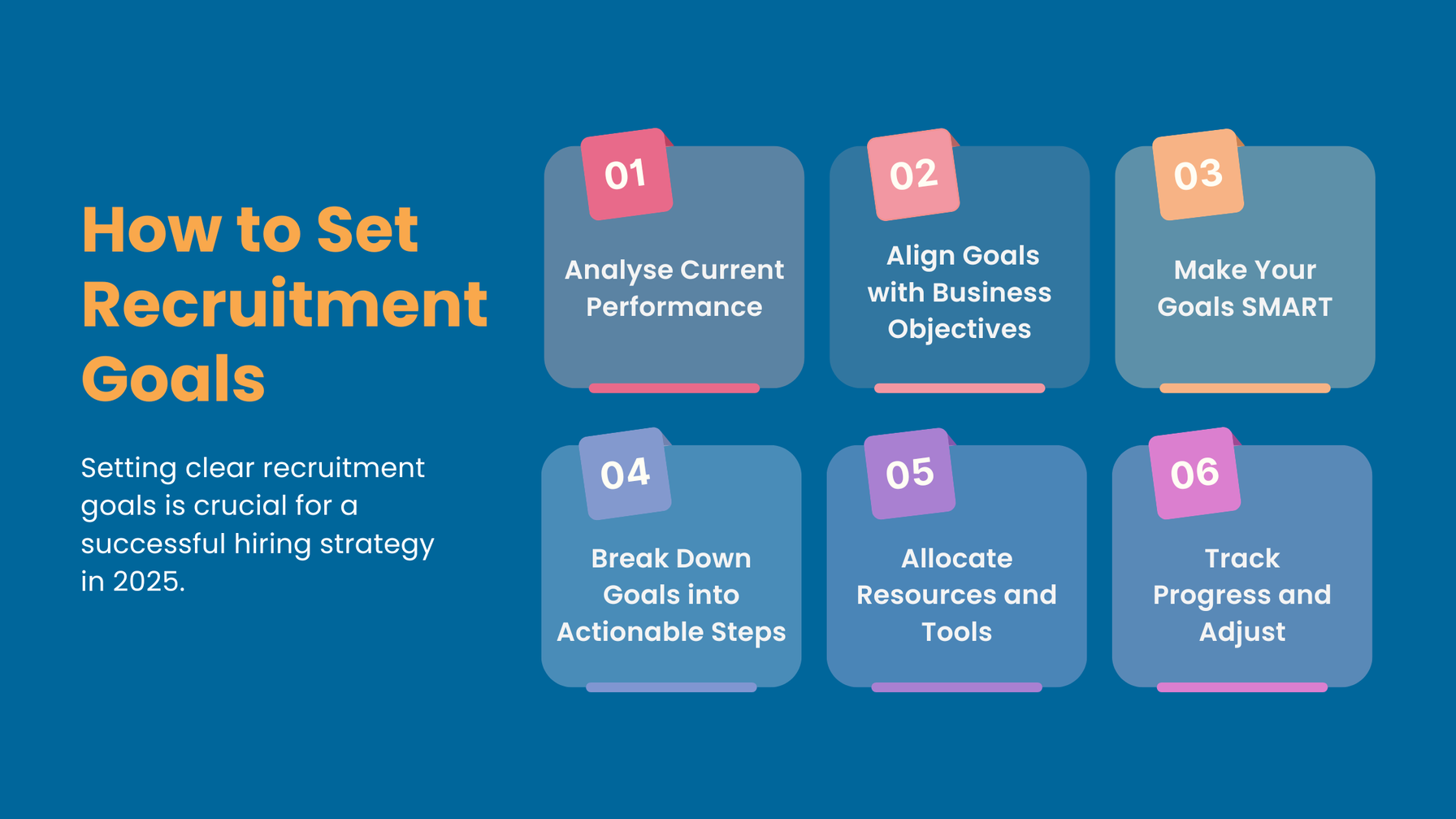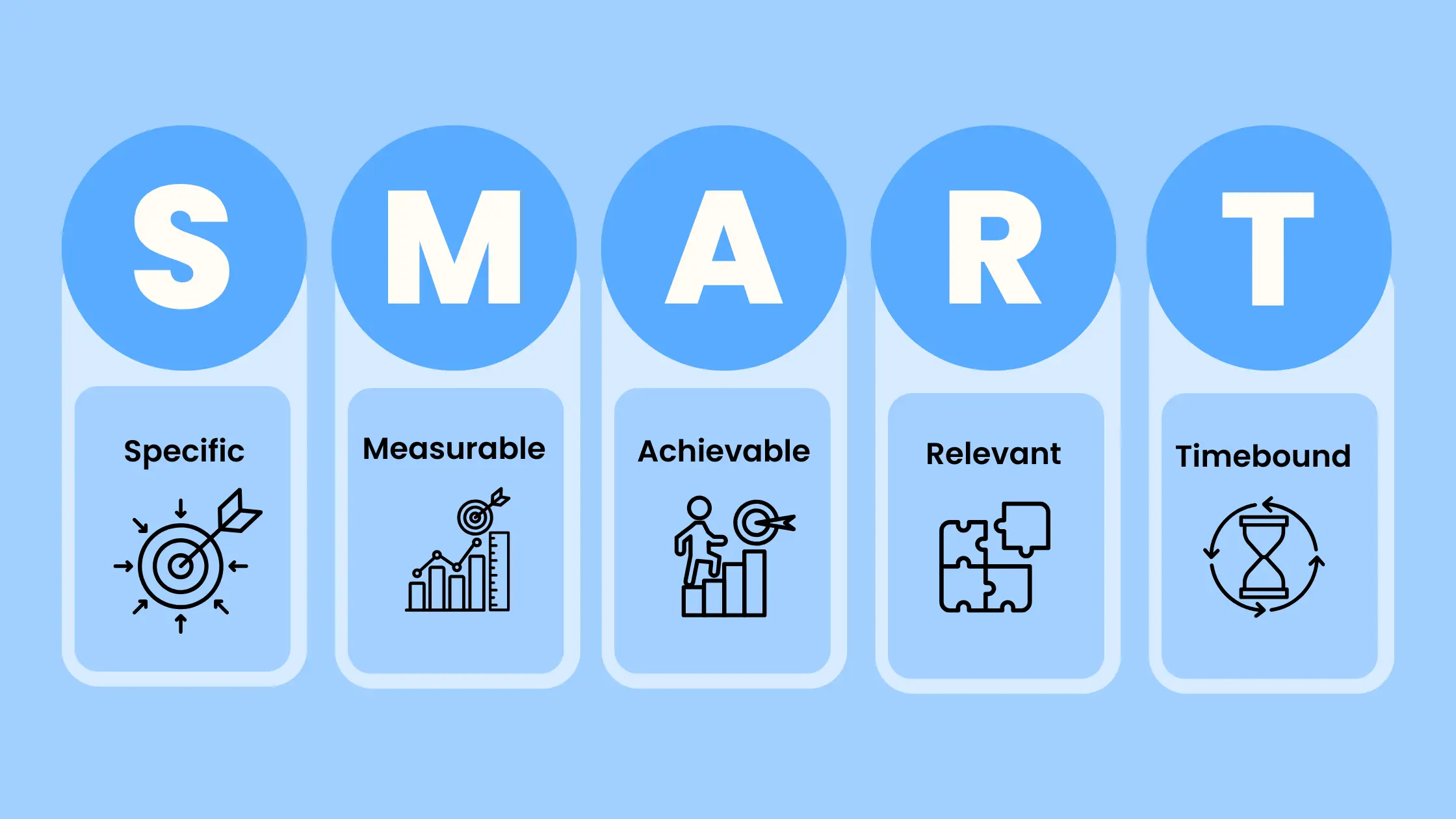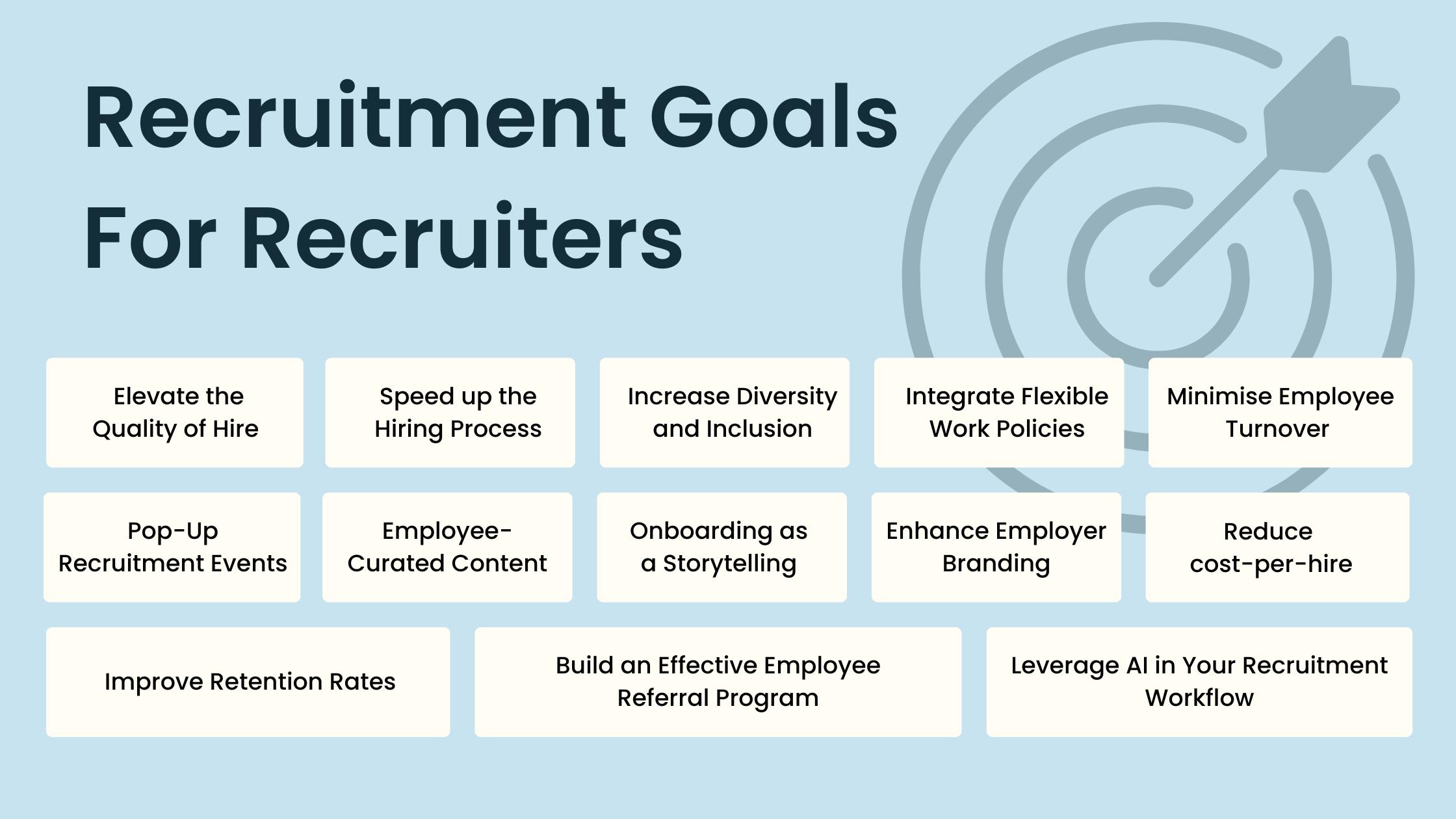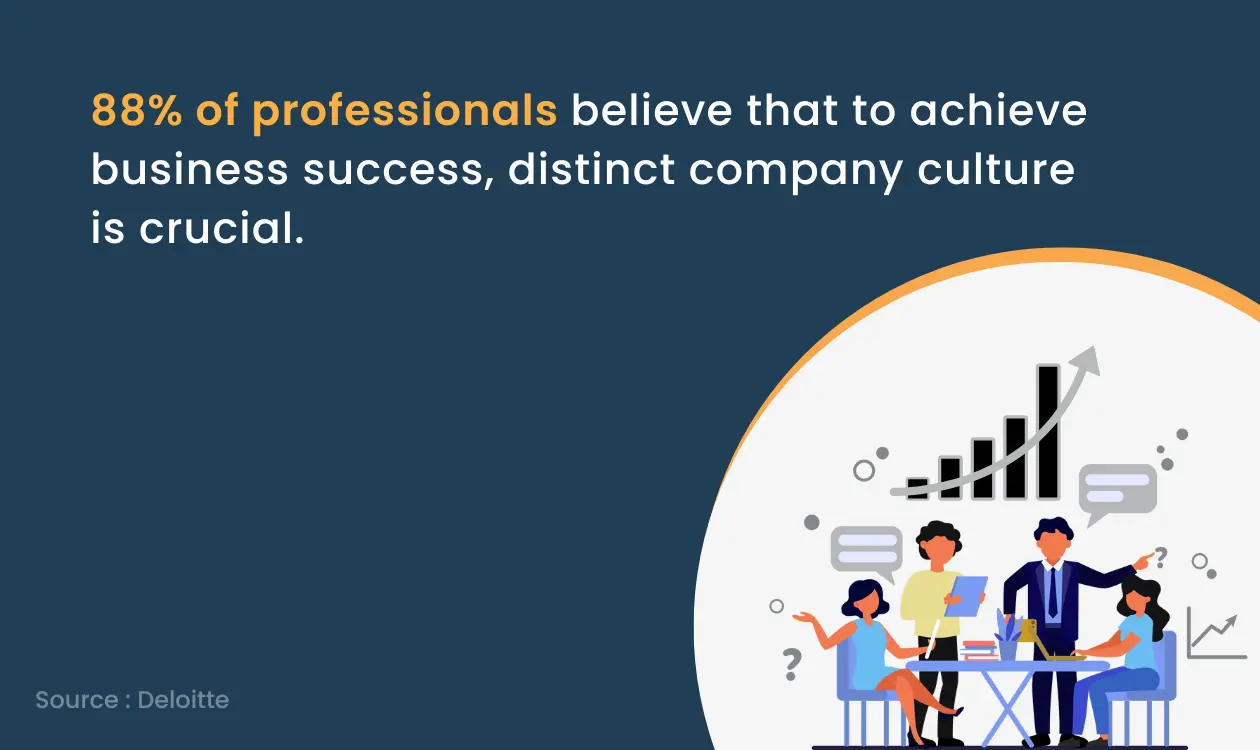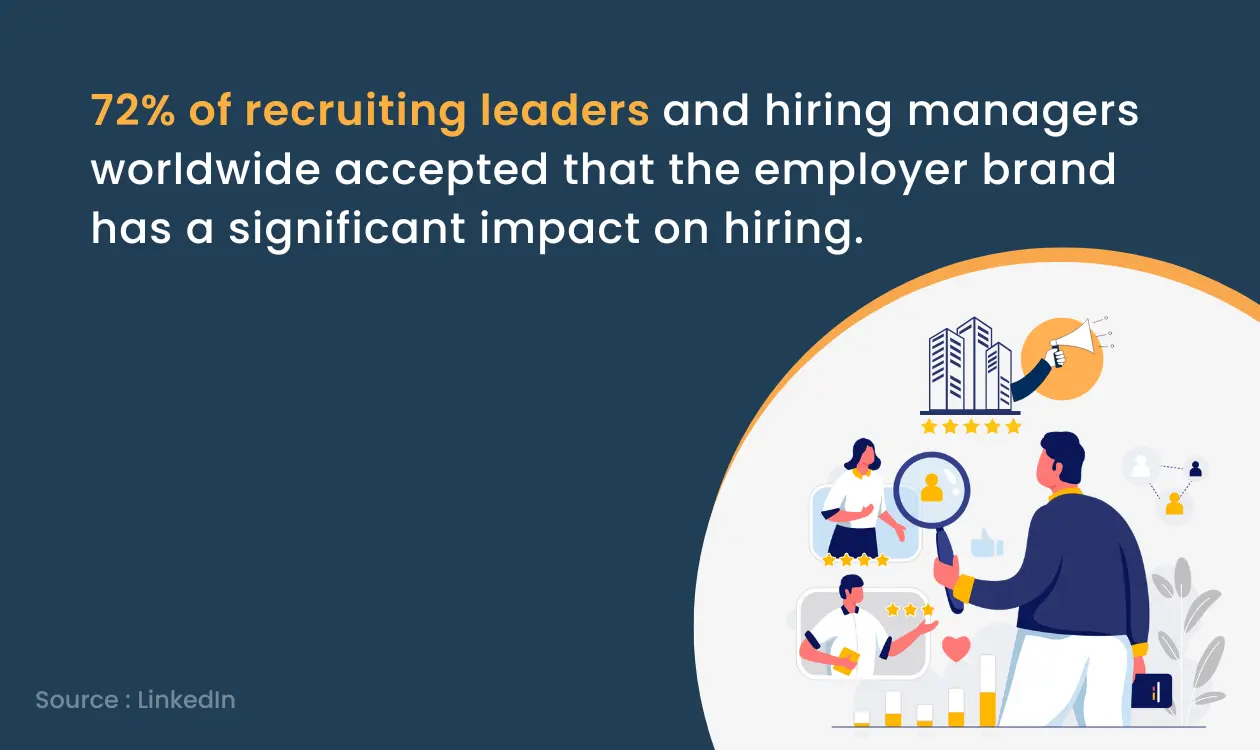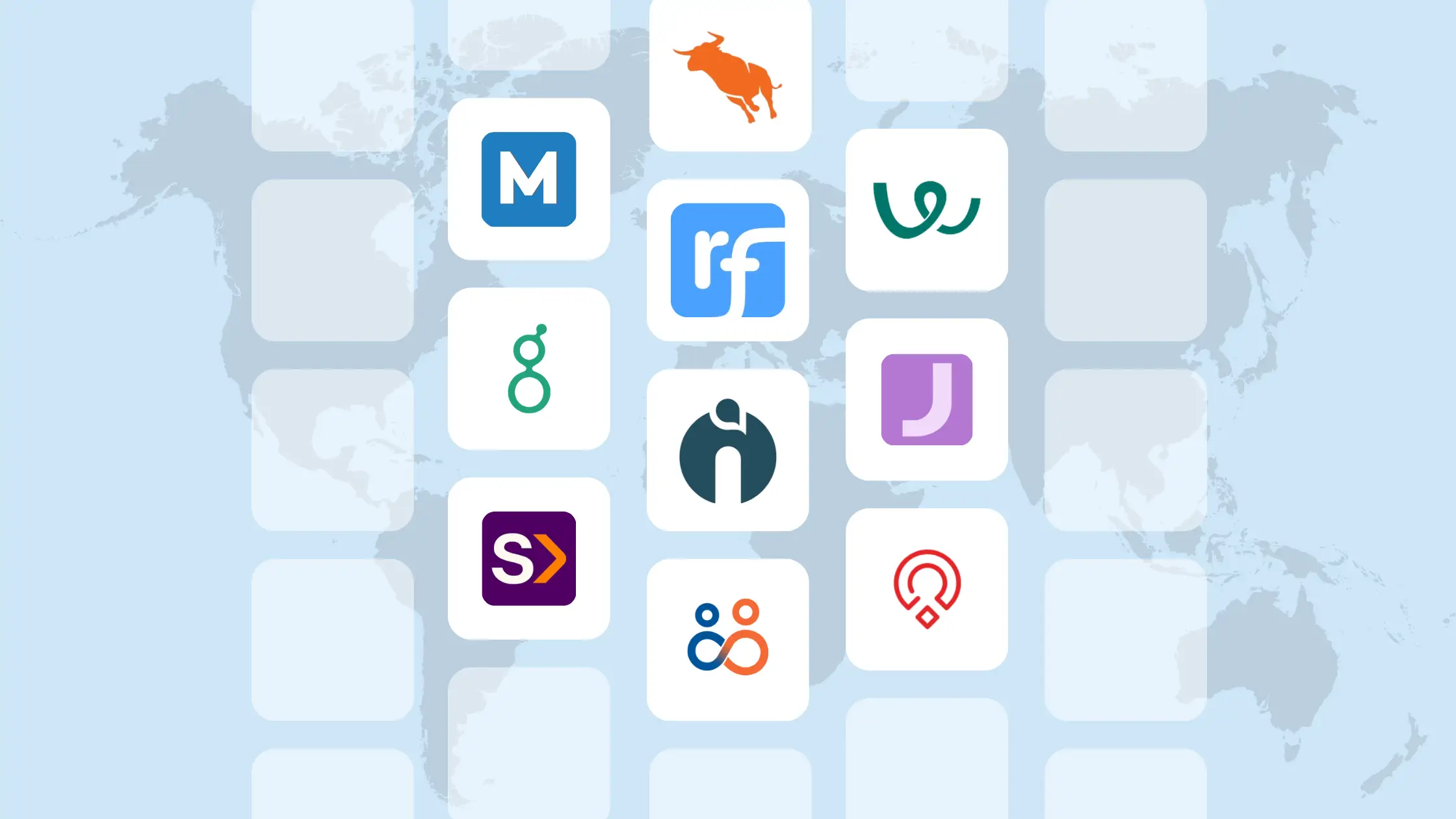Ditch the dusty decade; 2025 is here, and it's time to shake up your recruitment game! Time to recruit the best talent to create your dream team.
Instead of relying on luck, chart your course with targeted goals. This isn't just about filling vacancies; it's about attracting top talents who elevate your team.
Think of it as planning a road trip. You wouldn't drive aimlessly, right? Set your course and milestones because top talent doesn't appear magically. Recruitment goals & objectives are your guide to recruitment success, leading you to the perfect talent fit.
By the time you finish reading this blog, you’ll have a list of clear recruitment objectives to attract top talent. Buckle up; it's time to dive in!
What are the Recruitment Goals, and Why Should You Implement Them?
Recruitment goals serve as specific objectives for recruiters to enhance their performance and streamline the hiring process. It is also known as hiring goals or talent acquisition objectives.
These goals are essential because they provide recruiters with a clear direction, guiding their efforts in attracting and selecting the most qualified candidates for available positions within a company.
By precisely identifying areas that require improvement in the hiring process, these goals enable recruiters to adjust and optimise their recruitment methods effectively.
The significance of these recruitment objectives lies in their capacity to improve the efficiency and focus of the hiring process, ultimately contributing to the development of a skilled and effective workforce, which is crucial for the organisation's success.
So, are you ready to elevate your recruitment journey? Then, let’s start with the top recruitment goals you can prioritise and implement to get succeed in 2025.
Why It's Important to Set Recruitment Goals?
Recruitment goals are more than just targets; they are the foundation of a successful hiring strategy. In 2025, the talent landscape will be increasingly competitive, so it’s crucial to set clear recruitment objectives. Without defined goals, hiring teams risk wasting resources, attracting the wrong candidates, or extending the hiring process.
Setting recruitment goals allows you to streamline your efforts by identifying key areas for improvement, such as reducing time-to-hire, enhancing candidate experience, or improving the quality of your hires. These recruitment objectives also enable companies to address hiring challenges proactively.
In 2025, setting recruitment goals ensures your team not only fills roles efficiently but also contributes to building a high-performing, engaged workforce that drives business success.
How to Set Recruitment Goals: A Step-by-Step Guide
Setting clear recruitment goals is crucial for a successful hiring strategy in 2025. Here’s a simplified guide to help you focus on the essentials:
1. Analyse Current Performance
Start by reviewing key recruitment metrics like time-to-hire, quality of hire, and turnover rate. This analysis will help you identify areas that need improvement.
- Action: Review last year’s data to spot trends and bottlenecks. For example, high turnover might indicate a need to refine the onboarding process.
2. Align Goals with Business Objectives
Your recruitment goals should support the company’s overall strategy. Discuss future plans with stakeholders to understand workforce needs.
- Action: If your company is expanding into new markets, set a goal to build a talent pool in that region. This ensures recruitment efforts directly support business success.
3. Make Your Goals SMART
Define Specific, Measurable, Achievable, Relevant, and Time-bound (SMART) goals for clarity and tracking progress.
- Example: Instead of “hire faster,” make it SMART: "Reduce time-to-hire for engineers from 45 to 30 days by Q1 2025."
4. Break Down Goals into Actionable Steps
Outline specific actions required to achieve each goal, making it easier to implement and monitor progress.
- Action: If improving the quality of hire is a goal, refine job descriptions, introduce skill assessments, and use structured interviews.
5. Allocate Resources and Tools
Identify the resources needed to achieve your recruitment goals, such as recruitment software or team training.
- Action: To speed up hiring, consider an ATS for resume screening and interview scheduling. Assign a budget and team members to manage these tools.
6. Track Progress and Adjust
Regularly monitor recruitment metrics to ensure you’re on track. Be ready to adjust strategies based on results.
- Action: If time-to-hire goals aren't being met, re-evaluate your process. Implement additional strategies like virtual interviews to speed up scheduling.
This concise guide focuses on the most impactful steps, helping you set and achieve recruitment goals effectively for 2025.
Top 13 Crucial Recruitment Goals in 2025
In 2025, the recruitment game is all about playing smarter, not harder. Forget endless resumes and gut-based decisions – it's time to set strategic recruitment goals that elevate your talent acquisition and build a team that truly fuels your success. Here are the top 13 smart recruitment goals to conquer in the year ahead!
1. Elevate the Quality of Hire
Finding the perfect hire is like searching for a four-leaf clover – rare but rewarding. To improve your odds, start with clear job descriptions that reflect your company culture. Then, use skill-based assessments to identify candidates who not only match your skills but fit seamlessly into your team. It starts with understanding "quality of hire" - not just skills, but someone who thrives in your company culture and delivers results.
Start by crafting accurate job descriptions that paint a clear picture of the role and company culture. Then, use skill-based assessments to go beyond resumes and identify candidates who possess the core competencies necessary for success.
Next, Shift away from one-size-fits-all interviews and embrace structured, behavioral interviews. Pose questions that delve into candidates' past experiences, revealing their problem-solving skills, communication style, and cultural fit – aspects often overlooked by traditional "tell me about yourself" queries.
Reference checks should not be overlooked, either. They provide an opportunity to verify a candidate's background, past performance, and behaviour in previous roles.
Involve your team in the process. Let them assess candidates through panel interviews or ask for feedback – their insights are invaluable. Finally, measure and refine your hiring process. By focusing on these strategies, you can elevate the quality of your hires.
Bonus Tip: Don't just focus on a polished resume; look for passion, problem-solving abilities, and a growth mindset that aligns with your company culture.
2. Speed up the Hiring Process
Time is money, especially in today's competitive talent market. But dragging out the hiring process can cost you more than just cash—it can scare off top candidates and leave crucial roles vacant. In 2025, speeding up your recruitment isn't a luxury. It's a necessity.
Here are a few aspects you should consider:
- Streamline the Application: Forget lengthy, outdated applications for quick, mobile-friendly forms. Focus on essential skills and experiences instead of irrelevant fields.
- Embrace Automation: Let technology be your friend. Use an Applicant Tracking System (ATS) to automate tasks like resume screening and scheduling. This frees up your time for deeper interactions with promising candidates.
- Interview Smarter, Not Longer: Conduct initial rounds via video interview, allowing for faster scheduling. You can also utilise pre-recorded video questions to eliminate logistical hurdles and get everyone on the same page.
- Communicate Clearly: Keep candidates informed, provide regular updates, even if brief, and show respect and engagement, which are crucial for attracting and retaining top talent in a fast-paced market.
Remember, speed doesn't mean sacrificing quality. By making smart adjustments and leveraging technology, you can turbocharge your hiring process. And in 2025, the most efficient recruiters will be the ones who win the talent race.
3. Increase Diversity and Inclusion
In 2025, diversity and inclusion (D&I) focus on more than just numbers—it’s about building a team that fuels creativity and innovation. It’s one of the recruitment goals that gives you long-term benefits. Diverse teams bring fresh perspectives, solve problems faster, and stay engaged. How can you make D&I part of your recruitment process?
Start with inclusive job descriptions. Use language that invites all groups to apply and focus on essential skills and values instead of terms like "rockstar" or "ninja."
Expand your sourcing channels. Look beyond the usual places by posting on diverse job boards or partnering with organisations supporting minority groups. AI tools can help reduce bias during screening, ensuring everyone gets a fair chance.
Diversity and inclusion are long-term commitments. By fostering a welcoming culture where all employees feel valued, you'll attract and retain top talent from all backgrounds.
Pro Tip: Encourage open discussions, offer diversity training, and celebrate different perspectives to create a lasting culture of inclusion.
4. Build an Effective Employee Referral Program
Building an effective employee referral program is more than just offering incentives; it's about leveraging your employees' networks and enthusiasm. To motivate referrals, offer compelling incentives like monetary rewards, career development opportunities, or extra time off. Ensure transparency by keeping employees updated on the status of their referrals.
Encourage employees to refer candidates who not only have the right skills but also align with your company’s culture and values. Implement a user-friendly referral platform to streamline the process, making it easy for employees to participate. Track key metrics like referral-to-hire conversion rates and time-to-fill to continuously improve the program.
Remember, a successful referral program is built on mutual benefit—your employees' satisfaction fuels the flow of quality referrals, creating a win-win scenario.
5. Integrate Flexible Work Policies
Integrating flexible work policies is crucial in today’s evolving work environment. Candidates highly value work-life balance, and companies offering flexibility—like remote work, flexible hours, or compressed weeks—are better positioned to attract and retain top talent.
Why is this important for recruitment goals & objectives? Flexible options appeal to a broader range of candidates, particularly those seeking alternatives to the traditional 9-to-5 office setup. It also boosts employee satisfaction and reduces turnover by allowing workers to manage their schedules.
How to implement flexible work? Tailor policies to your team's needs—some roles may suit full-time remote work, while others might benefit from hybrid models. Communicate expectations clearly, use the right tools, and stay connected with regular check-ins.
By integrating flexible work policies, your company remains competitive and employee-focused.
Pro Tip: Flexible work isn’t just about location—think about flexibility in terms of hours as well. Allowing employees to start and finish their workday when it suits them, within reason, can greatly boost morale and productivity. Ensuring proper workday testing can further enhance efficiency and adaptability in this flexible approach.
6. Minimise Employee Turnover
Ever wondered about the ebb and flow of employees in a company? That's what we call Employee Turnover—the constant cycle of hiring and firing within an organisation. It's a pivotal metric in data-driven recruiting, and while turnover is a natural part of employee life, consistently high rates can be a red flag. That's why it's on the checklist of smart recruitment goals for 2025.
To address this, Regularly gather feedback through surveys and exit interviews to identify underlying issues and address them proactively.
Don't burn your brightest stars. Offer flexible work arrangements like remote options or compressed workweeks. Foster a culture that respects downtime and encourages healthy boundaries.
Competitive compensation and benefits packages, along with recognition and rewards for achievements, can increase employee satisfaction and loyalty. Additionally, mentorship programs should be established to support employee engagement and retention. The recruiting company must calculate the turnover rate to form a talent pipeline before any open position arises.
Setting recruitment goals inherently involves calculating turnover rates, typically averaging around 2.5%.
7. Reduce your cost-per-hire
In the realm of recruiting, where budget constraints are crucial, the ultimate metric is Cost-Per-Hire. A universal pain point for recruiters, it's non-negotiable in our list of recruitment goals and objectives.
Cost-per-hire represents the dollars spent by an employer to bring a single candidate on board. It's not just a number; it's a crucial indicator of overall hiring expenditure. Calculation of cost-per-hire will help you optimise the existing hiring process and make a paramount decision to better with the minimum amount.
Action Steps for 2025:
- Targeted Job Advertising: Use data analytics to identify the job boards and social media platforms where your ideal candidates are most active. Invest in targeted advertising campaigns to reach these candidates directly, maximising your budget's impact.
- Referral Programs: Enhance your employee referral program to leverage your team's network. Referrals often result in quicker hires at a lower cost compared to traditional recruitment methods.
Bonus Tip: Remember, reducing cost-per-hire is about optimising your process, not cutting corners. Regularly review your cost-per-hire metrics using an AI-powered recruitment dashboard. Use these insights to continuously refine your sourcing and hiring strategies, ensuring an optimised recruitment budget.
8. Enhance Employer Branding
A strong one Your employer branding is your company’s talent magnet. A strong brand draws top performers, while a weak one turns them away. To make yours irresistible, focus on authenticity and value. Showcase your true company culture through employee stories and transparent communication—highlighting values, challenges, and successes in a genuine way.
Empower your employees to be brand ambassadors, sharing their experiences on social media and review platforms. Their voices build trust and show what it’s like to work with you.
Go beyond salary—today's talent seeks meaningful work, professional growth, and real impact. By consistently living your values and prioritising employee well-being, you'll naturally attract top talent.
9. Leverage AI in Your Recruitment Workflow
Upgrade your recruitment game in 2025 with the power of AI! Discard the manual grind and embrace these game-changers!
Candidate sourcing and AI candidate matching can help you identify potential candidates by analysing resumes, social media profiles, and other sources, streamlining the initial stages of recruitment.
AI job matching helps you align job requirements with candidate skills more efficiently.
Email synchronisation and resume parsing tools integrate with your email and ATS, automatically extracting candidate data and saving time on manual data entry.
Chatbots and virtual assistants provide instant responses to candidate inquiries, enhancing the candidate experience.
Automated interview scheduling tools use AI algorithms to find the best interview slots, reducing scheduling conflicts and speeding up the interview process.
Remember, AI is a tool, not a replacement. Use it to augment your human expertise and build a more efficient, effective, and ultimately, more human-centered recruitment process. Happy hunting!
10. Improve Retention Rates
Improving employee retention rates should be one of the key recruitment goals. Hiring great talent is just the beginning - keeping them is the true challenge. High turnover is costly in terms of both finances and morale. When an employee leaves, you lose their skills and must invest time and resources into finding and training a replacement.
To boost retention, create an environment where employees feel valued and supported. Regular pulse surveys or one-on-one check-ins can help identify challenges. Recognise contributions, offer flexible work options, and prioritise mental health and work-life balance. Employees who feel their well-being matters are more likely to stay.
Provide clear development paths and training to keep employees engaged and foster a strong company culture that connects people to your mission and values. In short, retention is about creating a workplace where employees feel valued and supported and see a future for themselves.
Pro Tip: Building a culture of recognition and appreciation goes a long way. Celebrate wins, no matter how big or small, and make sure your employees know they’re making an impact.
11. Onboarding as a Storytelling
Think of onboarding as the first chapter in your company’s story. Instead of just giving new hires policies and procedures, guide them through your company’s mission, values, and culture. Show them how their role fits into the bigger picture, making them feel like they’re part of something meaningful.
When employees see themselves as key players in the company’s success, they’re more engaged and excited to contribute. It’s about creating a connection between their work and the company’s goals.
To make onboarding feel like storytelling:
- Start with your company’s mission and vision - Explain the “why” behind what you do.
- Show their role in the story - Make it clear how they can make an impact.
- Introduce the key players - Help them connect with the team by sharing the stories of others.
- Continue the story - Offer ongoing support and development to keep them engaged.
By framing onboarding as a story, you’ll create a more engaging experience that inspires new hires to become part of your company’s journey.
12. Employee-Curated Content
Employee-curated content is a powerful way to give potential candidates an authentic glimpse into your company culture. When employees share their stories - whether through blog posts, videos, or social media - they become ambassadors for your brand, showcasing what it's really like to work at your company.
Candidates trust real experiences, and this kind of content helps them connect with your values and decide if they’re a good fit. To get started, encourage employees to share their perspectives and support them with tools to create engaging content. Authenticity is key, so let employees share their own style to attract like-minded talent.
13. Pop-Up Recruitment Events
One of your key recruitment goals for 2025 should be to leverage pop-up recruitment events. These spontaneous, high-energy events - whether in-person or virtual - allow you to quickly attract and engage top talent. Instead of relying on traditional hiring methods, pop-up events provide a fresh, interactive way to connect with candidates who might not be actively job hunting but are curious about new opportunities.
By organising pop-up recruitment events at industry conferences, community gatherings, or even online, you can showcase your company’s culture in a more personal setting. These events are perfect for building a talent pipeline and making your recruitment process more dynamic.
Are you Ready to Implement Recruitment Goals for 2025?
As we set our eyes on 2025, embracing the above-mentioned recruitment goals promises not just to boost your offer acceptance rate but also to provide a robust reinforcement of your employer branding. The ripple effect, right?
Implementing the above hiring goals will lead to a more effective recruitment process, successful hires, and significant improvements in your company.
So, are you ready to experience the recruitment magic? Book your free demo today and see how AI recruitment technologies can revolutionise your hiring success. Watch your 2025 transform from promising to phenomenal, powered by the game-changing force of AI in recruitment.
Will you seize the opportunity to stay ahead in the competitive world of talent acquisition, or will you let it slip through your fingers? The choice is yours now!





1.webp)
